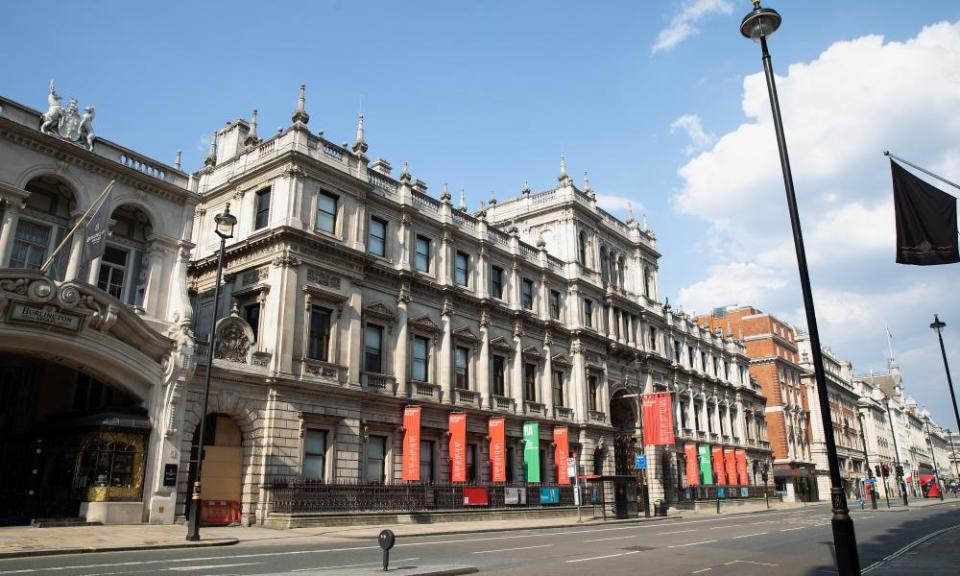Gilbert and George quit Royal Academy over dashed hopes for major exhibition
Artists Gilbert and George, unpredictable celebrities of the British avant garde, have perplexed the art world together for more than five decades. Their provocative murals, posters, photographs and videos have surprised and often unsettled fans. But now the artists, who revel in a joint reputation “as horrid people”, have fallen out with one of Britain’s most prestigious cultural institutions – the Royal Academy of Art.
The two artists have taken the dramatic step of resigning from the RA in reaction to a decision not to go ahead with an exhibition they had been planning to stage in the academy’s Piccadilly galleries.
A February interview with the duo, Gilbert Prousch, 76, and George Passmore, 78, referred to the high-profile show they believed they had been offered. But only a few days later, after learning it was not to happen, they resigned as academicians, something that has not happened since 2005, when Peter Blake reportedly quit in protest over the expulsion of his friend Brendan Neiland, the former director of the RA school.
Related: 'Don't catch it!': Gilbert & George make free coronavirus artwork
Gilbert and George’s London representatives at White Cube gallery were approached for comment, but did not offer one.
Gilbert and George, who have been praised for a fertile phase of creativity during lockdown, were elected to the academy in only 2017. It was a decision, voted upon by the other academicians, that caused a stir not just because the duo are infamously unclubbable, but also because they were the first pair of artists in the institution’s 250 years to be admitted formally as one entity, with a sole vote allotted to them.
The RA, founded by King George III, was set up in 1768 by a group that included society artists Joshua Reynolds and Angelica Kauffman. Becoming a royal academician is still regarded as a key token of recognition among the artistic community.
But Gilbert and George, who have worked together on conceptual and visual projects from their home in east London since the late 1960s, tendered their resignations at the end of February in protest at the RA’s handling of the hoped-for exhibition.
Speaking to the Evening Standard newspaper in February they mentioned the show in the RA’s Burlington House headquarters as a future highlight. “It is extraordinary that we’ve been able to risk extreme artwork for 40 years,” said Prousch. “You have to be an outsider to do art, you can’t be normal.”
An RA spokeswoman told the Observer that the resignation of Gilbert and George was regrettable. Not all the academicians can have an exhibition, she added, and the RA is forced to make decisions about who to show and when.
Speaking this weekend, an anonymous academician said the situation was unfortunate, and Gilbert and George “should not have just assumed they would be given a show”. But an admirer of their work, aware of the brewing dispute, felt blame lay with the RA, and the question of giving them a show had been badly mishandled.

There are currently 77 royal academicians. They must be artists or architects under the age of 75, and there are never more than 80 of them. When they reach 76, they become senior academicians and replacements are elected after a lengthy nomination process.
Artists Jane and Louise Wilson were the second duo, and the first twins, to be jointly made a Royal Academician.
Related: Lockdown with Gilbert and George: they've lost the world, but the walk goes on
Prousch, who was born in the Italian Tyrol and who studied art in Germany before coming to England, met Passmore in 1967 when they were studying at the influential St Martins School of Art in London. Since then they have busted taboos with glee, keeping a veil of mystery over the nature of their domestic relationship until they celebrated a civil partnership in 2008.
During lockdown they started an online video diary, posting weekly updates on life in their newly limited circumstances. The bulletins, often short films, were a continuation of their usual creative habit of documenting social change. Their work, which has covered the skinhead movement, the youth craze for consuming nitrous oxide, and the Brexit campaign, has often pushed against the shared liberal attitudes of the wider artistic community.
Last month, the pair confounded those who criticise their Conservative political allegiances when they donated art to be sold as dinner crockery to raise money for a social enterprise run near their home of 50 years in Fournier Street.
The Royal Academy
The RA has often been at the centre of creative battles, in fact it is almost its purpose. In February 1790, after a row over the appointment of the Italian architect Giuseppe Bonomi as Professor of Perspective one of the RA’s founders, Reynolds, tendered his resignation both as president and as an academician.
And on the eve of the annual Summer Exhibition in 1832 JMW Turner is said to have objected to his seascape Helvoetsluys being hung next to JM Constable’s colourful painting The Opening of Waterloo Bridge. To avoid being upstage he retaliated by daubing his canvas with a bright red dot, later disguised as buoy. When Constable saw it he is said to have declared: “He has been here and fired a gun.” The incident features in Mike Leigh’s 2014 film Mr Turner.
When in 1997 former RA president Norman Rosenthal decided to display 110 works owned by collector Charles Saatchi in the contemporary show Sensation, it prompted anger among some academicians. Marcus Harvey’s large portrait of ‘moors murderer’ Myra Hindley, depicted in children’s handprints, was enough to push the acclaimed colourist Gillian Ayres to resign.

 Yahoo News
Yahoo News 
